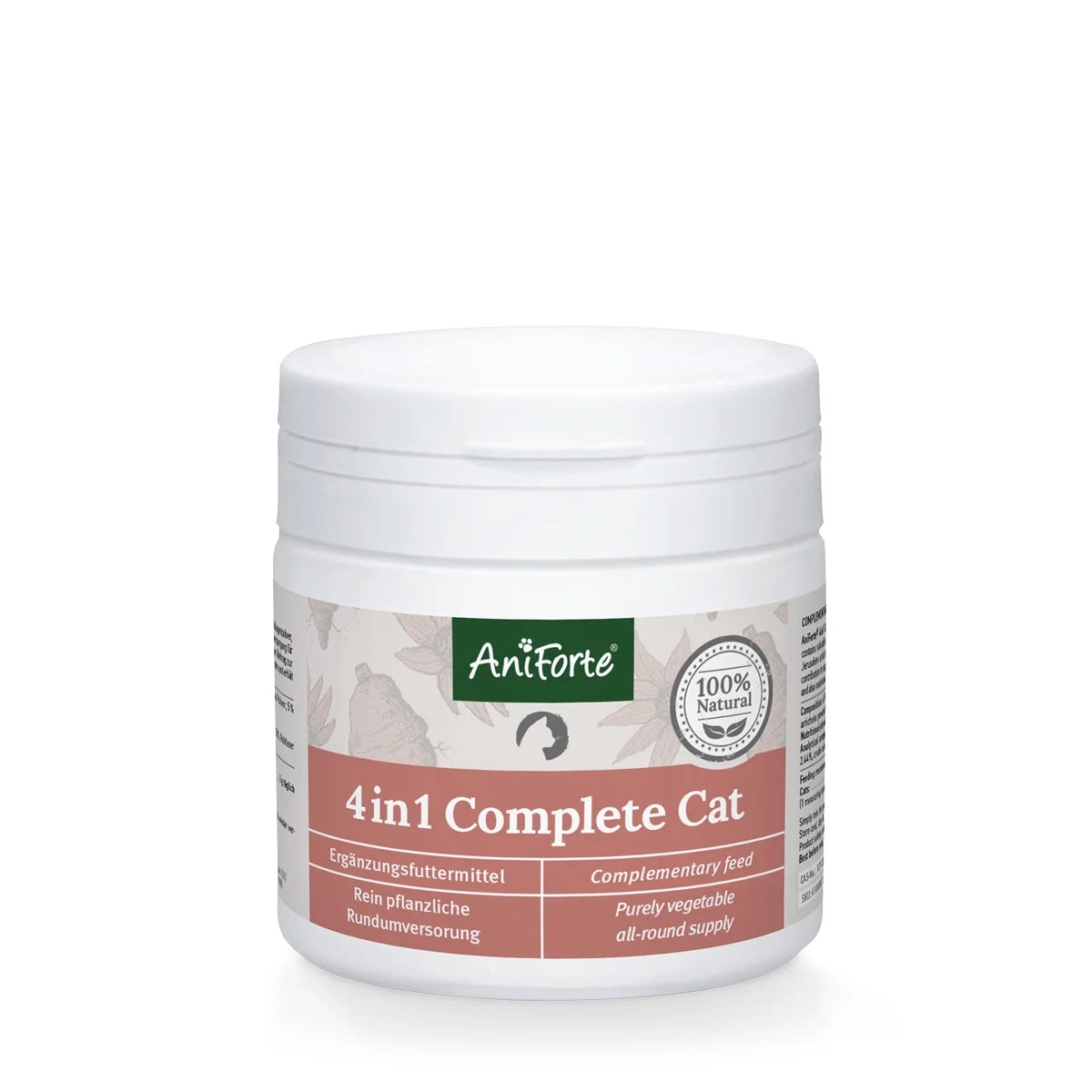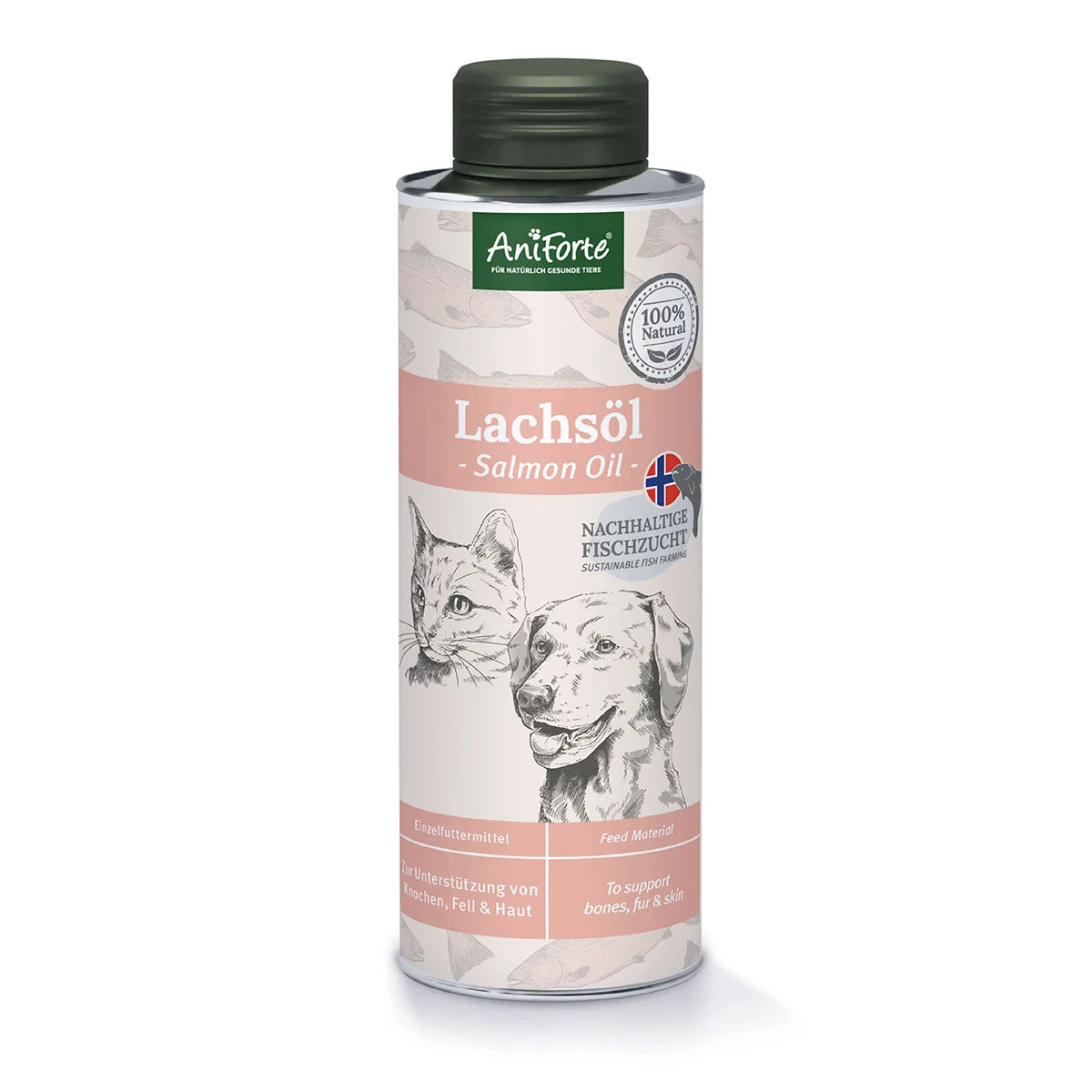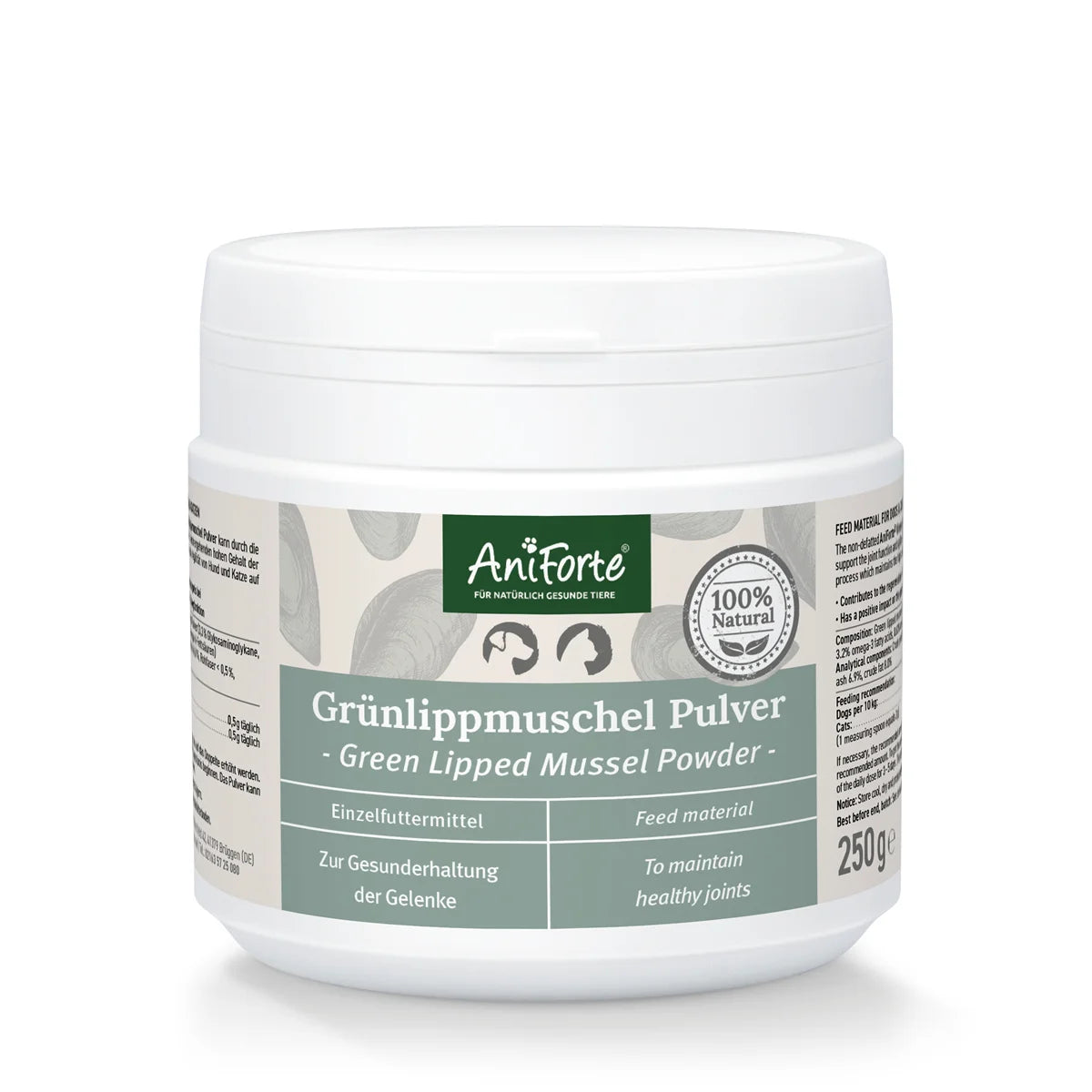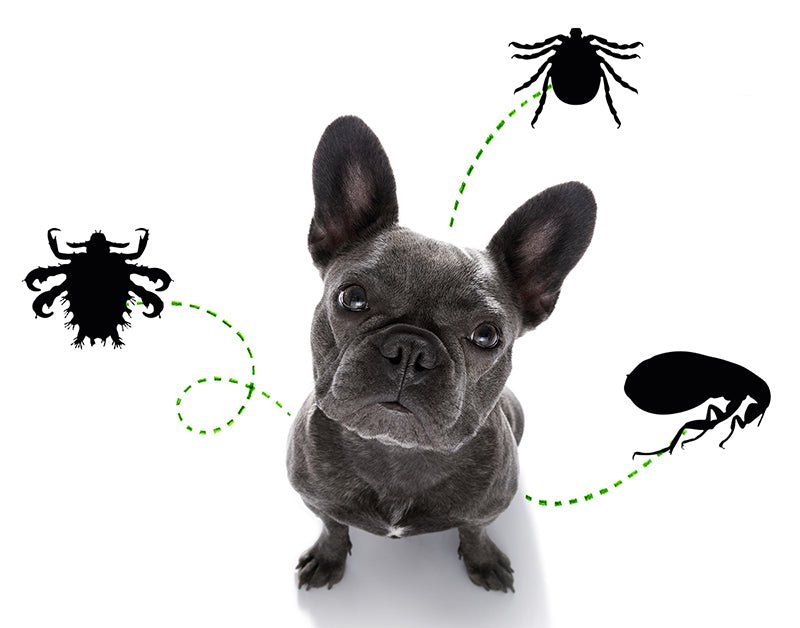Parasites in pets are not a fun topic, but unfortunately a very prevalent one. Once Spring arrives, the pests start crawling out of their hiding places and look for a host in order to feed and reproduce. The consequences of such an ectoparasite infestation are not always harmless. Today we will give you an overview of the most common ectoparasites in your dog or cat. Find out how you can put an end to annoying skin parasites and how to use natural means to prevent re-infestation.
What are ectoparasites?
Ectoparasites are external parasites that attach themselves to the host's skin and may introduce pathogens through their host's skin. They take food from your pet over a longer period of time in the form of skin flakes, blood or use it to lay eggs. The most common ectoparasites in pets are fleas, ticks and mites. But mosquitoes and lice also belong to this group of insects, so dogs and cats must also be protected from them. Because they too can smuggle pathogens into the body, some of which cause life-threatening diseases in our furry friends. Here, we list the most common ectoparasites, we tell you how you can best recognize them, as well as the corresponding treatment and prevention.
1. Lice in dogs and cats
General information
These arachnids are loyal to one host and spend their entire life on them. Lice feed on the host's blood. Lice infestations have decreased significantly, especially in domestic animals, which may be due to the increasing care of animals and the decrease in spread of stray animals. The most widespread louse species belongs to the genus Anoplura. The most relevant louse on dogs is the Trichodectes canis, and the variety that most commonly affects cats is the Felicola subrostratus.

How do I recognize lice on my pet?
In contrast to fleas, lice can be easily recognized as they don't travel that fast and like to attach their eggs to the hair shafts. A careful examination of the fur and skin can identify lice in dogs and cats very well. You can also use a flea comb and stroke through the fur. Use adhesive tape to help, the eggs and the lice will stick to it.
Symptoms of lice infestation in dogs and cats:
- Itching and increased scratching
- Alopecia (sudden hair loss)
- Redness and swelling of the skin
- Secondary bacterial infection
- Lice infestation can lead to anemia in weak and young dogs
- Health effects of lice in pets
Lice are feared less because of severe secondary diseases, but mainly because an infestation affects the well-being of the animal. The pets can appear restless and irritable, the increasing scratching causes abrasions and possible infections with bacteria. Therefore, you should regularly groom the fur of your dog or cat in order to counteract these annoying pests.
What to do if lice affect cats and dogs?
The most important point in fighting lice is hygiene. If your furry friend is well cared for, the beasts won't even nest on them. Strengthening of the immune system is also an option, then a furry friend can fend off the lice on its own with its strong immune system. Otherwise, you can comb out lice, and one or two showers for your dog can drive away the arachnids. In addition, there are numerous collars, spot-ons and powders that are effective against lice. To alleviate the itching, you can apply aloe vera gel or marigold ointment to the reddened areas. Chamomile or quark can also help.
To prevent lice infestation, you should brush your pet regularly. As with the prevention of fleas, essential oils can also make a valuable contribution and keep the insects away from your animal.
2. Fleas in dogs and cats
General information
Fleas are one of the few insect varieties that are named after their favorite host. As the name suggests, dog fleas like to nest on dogs, cat fleas on cats, human fleas on people, etc. However, fleas are not limited to these hosts, but change providers if they need to. The most common flea in cats is Ctenocephalides Felis. The dog flea, Ctenocephalides canis, comes second and the Archaeopsylla erinacei, the hedgehog flea, is the third most common flea parasite.

How do I recognize fleas on my pet?
An infestation can cause symptoms of different degrees in dogs and cats. These are related to factors such as the colonisation of the host (strong or rather moderate flea infestation), possible existing skin infections and other diseases and the sensitivity of the animal.
Symptoms of flea infestation:
- Increased scratching and biting of the skin
- Red spots
- Alopecia (sudden hair loss)
- Blisters on the skin
- Scabs due to wound healing
- Bacterial skin infection
- Dermatitis
The most effective way to spot possible fleas on cats and dogs is by looking for flea droppings. Use a flea comb and first comb your pet’s fur “against the grain.” Then knock out the organic substances on a slightly damp paper towel. If there are brownish residues on the paper that turn rusty-reddish in color when crushed, there is a very high probability that this is flea excrement since flea droppings are digested blood and therefore have this red-brown color. If the color does not change, however, it’s not parasites but just dirt.
Health consequences of a flea infestation
The consequences of a flea infestation are not always harmless. Flea bites are not as serious as infected ticks or sand flies, but they can also trigger allergic reactions and even transmit pathogens.
Flea allergy dermatitis (FAD)
Fleas in dogs or cats are not only associated with increased itching and mild skin inflammation, but can also cause so-called flea allergy dermatitis (FAD). This allergy is a common reaction in pets to an increased flea infestation. The flea saliva can irritate the skin of the animal, which leads to increased scratching and under certain circumstances even cause purulent inflammation. This allergic reaction occurs in cats just as it does in dogs. A UK study in 2005 showed that 8% of the cats examined and 3% of the dogs showed symptoms of FAD. In any case, FAD should be clarified with the vet in order to be able to start targeted therapy. The use of cortisone or antibiotics cannot be ruled out if the course is severe.
Anemia due to severe flea infestation
A flea infestation can have serious consequences, especially for young dogs and cats, puppies and kittens. Fleas multiply at breakneck speed and can take up 15 times their body weight in blood per day. The already weakened organism is attacked and additionally weakened. Anemia can result. If you observe, in connection with a flea infestation, that your pet appears weak and lethargic, or has pale mucous membranes, then you should urgently visit the vet.
Tapeworm after flea infestation
The fact that fleas can also carry tapeworms does not seem to be well known. The cucumber tapeworm is an endoparasite that uses fleas as intermediate hosts and infects them as larvae. It then matures in the flea to an infectious tapeworm stage. Dogs and cats can swallow such an infected flea when they brush and bite their skin and ingest the tapeworm. The cucumber tapeworm affects dogs and cats alike and can be up to a meter long. Therefore, in the event of a flea infestation, it is also recommended to deworm the animal at the same time.
What to do if your cat or dog has fleas?
If, after the first symptoms of a flea infestation, flea droppings or live fleas are found in your pet's fur, a quick and extensive reaction is required. The animal must be treated with an appropriate antiparasitic in order to get rid of the parasites. There is a large selection of flea products from spot-on for dogs or cats to sprays, tablets and flea powder. Each product has its advantages and disadvantages.
Natural home remedies for flea infestation
Before resorting to synthetic flea products and possibly causing side effects in your friends, try natural flea products instead. These serve not only to eliminate fleas but also as a targeted prevention of fleas in dogs and cats:
- Black seed oil
- Coconut oil for cats and dogs
- Eucalyptus oil
- Diatomaceous Earth
- Brewer's Yeast
Thoroughly clean the area around the animal
Unfortunately, a flea infestation affects not only dogs and cats, but also the entire environment of the pet. Therefore, one treatment of the animal is not enough to eradicate the entire flea population. Because only fully grown fleas find their way to the host, larvae and flea eggs, on the other hand, are distributed in the vicinity of the dog or cat. You can find them in the dog and cat basket, on carpets, in bed and on many other textiles. Therefore, the entire environment must be treated and disinfected. Clean washable textiles at at least 60° C and use natural disinfectants to avoid possible allergic reactions.
3. Mites in pets
General information
Mites are also an ectoparasite that pet owners should not underestimate. Their widespread habitats make the arachnids a very resilient insect. The mite lives in the ground, in the sleeping areas of pets, on carpets and other textiles. The parasitic mite likes to attack dogs and cats, other mammals and of course us humans. It nests in the fur, on and in the skin, and feeds on its host’s dander, body fluids, and other organic tissue. Mites are active all year round.
The most common mites in dogs and cats are the ear mites, of the genus Otodectes cynotis, the autumn grass mites, of the genus Neotrombicula autumnalis and fungal mite infestation (Cheyletiella) is often diagnosed in dogs and cats.
The hair follicle mites, of the genus Demodex, and the grave mites of the genus Sarcoptes, occur mainly in dogs, while the head mites, Notoedres cati, are mainly found on cats.

How do I recognize mites on my pet?
Mite infestation in dogs and cats is also associated with increased itching. The annoying beasts cause inflammation on the skin and are very uncomfortable for the furry friends. However, specific symptoms depend on the particular type of mite. While ear mites mostly show itching and rashes on the ears, hair follicle mites go unnoticed most of the time.
Symptoms of mite infestation in dogs and cats:
- Increased itching
- Burning of the skin
- Vesicles and pustules
- Rash on the skin
- Red spots
- Crusts
- Flaking
- Hair loss
- Bald spots
If you recognize these symptoms in your animal, you should definitely visit the vet. After a detailed laboratory examination, they can determine the type of mite and suggest an appropriate therapy.
Health consequences of a mite infestation
While some types of mites eke out their existence inconspicuously on our pets, others can have unpleasant effects on your cat or dog. The most common signs of a mite infestation are itching, skin inflammation, usually as a result of severe itching, skin lesions or the formation of scales and crusts. However, each type of mite has different effects on the health of our animals, and some diseases can even be life-threatening. Here are the most common mite diseases in animals:
The skin disease Demodicosis
The hair follicle mites, for example, can cause the skin disease demodicosis in both dogs and cats. The localized form of this disease is basically harmless and will heal on its own. The generalised demodectic disease, on the other hand, is a serious disease in both animal species, very therapy-intensive and often indicates other underlying diseases and an additional bacterial infection. The demodicosis can be recognized by means of hairless areas, scales, crusts and nodular thickening of the skin, so-called papules. However, a final diagnosis should be made by your veterinarian. Demodicosis is rare in cats.
The Sarcoptic Mange
The highly contagious sarcoptic mange is triggered by grave mites and is transmitted through direct physical contact or an infected environment. The adult mites lay eggs in the upper layer of the skin, which hatch after a few weeks. The sarcoptic mange shows itself with very intense itching in dogs and cats. If the mange is still in the early stages, individual areas such as ears, joints, snout and also the lower abdomen are affected. In particular, increased scratching causes redness, lesions and inflammation of the skin. Encrustations, scales and cornifications are also signs of advanced grave mite mange. In humans, this condition is known as scabies and is caused by an infection.
The Notoedres Mange
This disease is very similar to sarcoptic mange, but occurs predominantly in cats. The symptoms are similar to those of sarcoptic mange and can be very uncomfortable for cats. Notoedres mange, if left untreated, can cause serious complications and even death.
External Otitis
External otitis is an inflammation of the animal's external auditory canal and is more common than ear mange. It occurs in both dogs and cats. Not always, but often an infestation with the mite Otodectes cynotis is the cause. This type of mite settles in the auricle and secretes brownish secretions on the surface. Itching is the animal's most common reaction. If the animal scratches too excessively, sequelae such as reddening and inflamed areas can occur, and sometimes an infection with bacteria.
What to do when cats and dogs have mites
While some effects of a mite infestation on pets will subside on their own, others can only be remedied with strong anti-parasitic agents. If you suspect mites in your furry friend, you should visit your vet who can take a sample and determine the exact type of mite.
Home remedies for mite infestation
Natural home remedies are also often used for mite infestation. Natural essential oils in particular have proven themselves useful against the annoying ectoparasites:
- Coconut oil
- Eucalyptus oil
- Paraffin oil
- Evening primrose oil
- Geraniol
The oil can contribute to wound healing, scares away the parasites through the intensive essential oils and prevents inflammation. If you suspect ear mites in your dog or cat, you can simply drip the appropriate oil onto a cloth and use it to clean the ear. Repeat the procedure several times.
In the event of a mite infestation, the dog should also be washed regularly; castile soap is particularly recommended here. It does not contain any artificial additives. In addition, it is advisable to strengthen your pet’s immune system, because particularly immunocompromised animals are preferred hosts for mites and other parasites.
To prevent a new mite infestation, you should treat your furry friend regularly with appropriate repellants, spot-ons or sprays, these are also available on a natural, non-chemical basis. In addition, thorough cleaning and disinfection of the animal's surroundings are necessary. Blankets and sleeping areas must be vacuumed, washed and disinfected. Floors, carpets and upholstered furniture should be cleaned thoroughly.
4. Blood-sucking ticks in dogs and cats
General information
One of the most infamous ectoparasites in our pets is the tick. This bloodsucker is not only annoying, particularly resistant and widespread, the tick also transmits serious diseases, both to animals and humans.
In our geographic region you will find mainly ticks from the family Ixodidae with their subspecies: the wood tick (Ixodes ricinus), the alluvial forest tick (Dermacentor reticulatus) and the brown dog tick (Rhipicephalus sanguineus). The latter is mostly imported from warmer regions through vacation trips. The local ticks are so-called three-host ticks and change hosts for each stage of development. The host's blood serves as food for the tick, especially before the egg-laying phase, the parasite soaks up really full and reaches a weight up to 200 times higher than before his meal.

How do I recognize ticks on my pet?
In the case of a tick infestation, the animal usually shows no symptoms, so you should check your dog or outdoor cat for these blood-sucking pests after every walk. You can simply stroke through the fur and search the animal thoroughly. In dogs with long fur, it is much more difficult and time-consuming to find ticks. It is even more complicated to recognize ticks in the larval and nymph stage, because they are significantly smaller than their fully-grown peers. Although they can find a place to suck blood on the whole body of the host, they prefer less hairy places such as ears, armpits, between the toes or on the stomach.
The main season of ticks is between March and November, depending on the species. The common wood tick has its most active phase from March to June and again later in the year from September to November.
Health consequences of a tick bite
Ticks are so dangerous because they can transmit diseases through bacteria and viruses in the saliva while they are sucking. In addition, you cannot tell whether the tick is infected with certain pathogens or not, which makes every tick bite a potential danger for you and your furry friend. But the fact that the bloodsuckers can transmit more than just one pathogen and the signs of an infected tick bite appear much later also makes the symptoms more difficult. So it is not surprising when one speaks of the insidious tick. The most common diseases in dogs and cats after tick bites are:
Lyme disease
The tick is not the cause of Lyme disease, it is simply the carrier of the pathogen. The common wood tick as the main carrier of this subliminal disease is infected in advance with the bacteria of the Borrelia group (Borrelia burgdorferi) and passes them on to its host. As a rule, it can take up to 24 hours for the bacteria to be transmitted to the host, which is why it is even more important to search the animal immediately after the walk.
While Lyme disease can be diagnosed early in humans by the so-called wandering redness around the bite, it is absent in dogs and cats as a sign of the transmission of Lyme disease bacteria. The first symptoms may not appear until days or weeks later.
Nonspecific symptoms of Lyme disease in dogs and cats:
- Limb and joint pain
- Swelling in the joints
- Polyarthritis
- Fever
- Swollen lymph nodes
- Fatigue, lethargy
- Inflammation of the kidneys
In order to diagnose Lyme disease in your furry friend, it is safest to examine the tick for possible pathogens. In practice, however, this is not always possible and hardly any pet owner goes straight to the vet with a tick. Blood and synovial fluid tests are possible alternatives if Lyme disease is suspected in dogs or cats, but these are not always clear because the animal does not produce antibodies. If your animal has been diagnosed with Lyme disease, antibiotics are usually administered.
Anaplasmosis
Anaplasmosis, also known as tick fever, is also transmitted by the common wood tick. The pathogens are Anaplasma phagocytophilum and after being transmitted by the tick, they attach themselves to the host's white blood cells. They can cause serious damage to the body and even lead to death if the infection is detected too late.
- Symptoms of anaplasmosis in dogs and cats:
- Fever lasting several days
- Muscle, joint pain and swelling
- Weight loss due to refusal to eat
- Vomit
- Diarrhoea
- Swollen lymph nodes
- Enlarged liver and spleen
The veterinarian can determine an exact diagnosis based on antibodies in the blood, but only about four weeks after the infection. Here, too, antibiotics are administered. If the disease is in the early stages, the treatment prospects are very positive.
TBE - Early Summer Meningoencephalitis
The causative agent of the early summer meningoencephalitis is the flavivirus, now also known as the TBE virus. The virus enters the bloodstream via the tick's saliva and can have serious consequences for the animal. In contrast to Lyme disease, there is no vaccine for dogs with TBE and the pathogen can pass to the host immediately after the puncture. If the disease is recognized early, it can be treated well. It is problematic, however, that dogs rarely show symptoms in the early stages and are therefore difficult to identify based on the symptoms in this phase.
The disease is particularly pronounced in animals with a weakened immune system. Therefore, in addition to early tick prophylaxis, it is advisable to strengthen the dog's immune system before the start of tick season.
Symptoms of TBE:
- High fever
- Behavioural problems such as aggressiveness, lethargy
- Cramps
- Paralysis
- Dodging when touched on the head and neck area due to pain
The diagnosis is made by the veterinarian using an antibody test. Antibiotic administration over a longer period of time is the result. Depending on the severity of the course, your furry friend must remain under observation by the vet. If the disease is already well advanced, the chances of recovery are rather slim. Therefore, if you first suspect TBE in a dog, you should consult the veterinarian immediately.
What to do if my pet has ticks
If you find a tick attached to your pet after a thorough search, don’t panic, because not all of these parasites are infected with a pathogen. According to the German Robert Koch Institute, only between 0.1% -5% of ticks in Germany are infected with the TBE virus. Borrelia-infected ticks can make up up to 30% depending on the region. If you still want to be on the safe side, you can pick up the tick after removing it and have it tested for possible pathogens by the vet. This is the safest method to detect a possible illness in your furry friend at an early stage.
How to remove ticks correctly
The tick should be removed along with its head. It is best to use tweezers or specific tick tweezers. Once you have gripped the tick, pull it out slowly. Be careful not to make any jerky movements, as this can tear off the tick's head more quickly. Once you have pulled the tick out, it is best to crush it with kitchen paper, because these beasts are true survivors. The puncture site is then thoroughly disinfected and treated with healing ointments.
Rumours persist that oil and other liquids make it easier to remove ticks. Refrain from doing that, because the tick can suffer a shock and release all of its intestinal contents into the puncture site.
Home remedies for ticks
Prevention against ticks is the best protection. Tick prophylaxis can be carried out using repellants. These repellants have the advantage of killing ticks before they bite. These are available as a spray or spot-on. There are now plenty of herbal anti-tick remedies available. The active ingredients are similar to those of the mite and flea preparations:
- Black seed oil
- Coconut oil
- Lemon oil
- Geranium oil
- Paraffinum
- Lavender oil
- Eucalyptus
- Neem tree oil
- Brewer's yeast can also be used as prophylaxis. It can support the immune system and build an internal defense against parasites.
5. Sand flies - the exotic pests
General information
In Europe, sand flies are mainly found in southern countries, the most widespread species is the butterfly mosquito (Phlebotomus). As a rule, the occurrence of the sand mosquito is not relevant for the UK, but pets, mostly dogs that have been traveling with their owners in southern Europe, can bring these mosquitoes home with them.
The sand fly does not like wind and is rarely seen near bodies of water. It only becomes active after sunset, when the nights are around 20° C cool. Only the female mosquitoes suck the blood they need for the eggs to mature.

Health consequences of sand fly bites - leishmaniasis
Sand flies are carriers of leishmaniasis, an incurable disease in animals. The pathogens of the genus Leishmania enter the host's body through a mosquito bite. After a short time, pink to red colored papules form at the puncture site. Itching and severe scratching are the result. This means that additional bacteria can be transported into the wound and hairless areas and scales are possible secondary reactions. Leishmanias can also affect organs and have already been detected in the animal's kidneys and bone marrow.
Other symptoms of leishmaniasis include:
- Increased tiredness and exhaustion
- Weight loss
- Muscle weakness
- Swollen lymph nodes
- Inflammation of the skin (dermatitis) mostly around the eyes, ears and nose
- Anemia rarely occurs
A veterinary diagnosis of the disease is necessary in any case. The earlier a possible infection is detected, the better the chances of treatment. However, leishmaniasis is usually fatal in dogs and cannot be cured.
Preventing leishmaniasis
There is now a vaccination against leishmaniasis for dogs. Although this does not offer 100% protection against the outbreak of the disease, it makes sense if you want your pet to travel to endangered regions with you. Veterinarians also recommend a combination of vaccination and spot-on against mosquito bites. It is also possible to protect the animal in the evening hours with a very close-meshed mosquito net.
There are hardly any natural home remedies for sand flies. Only scents such as lavender, lemongrass, sage, lemon balm etc. can help prevent bloodsuckers from going near them. However, they are not a reliable protection.
6. Mosquitoes - harmless for dogs and cats?
General information
Mosquitoes are found all over Europe. Their preferred area is near bodies of water because that is where they lay their eggs. Newly hatched mosquitoes are able to fly after an hour and are more active, especially during the summer months. Both female and male mosquitoes feed on the nectar of plants and are actually not dependent on the blood of other living things for food. The females of most mosquito species only need blood to form their eggs. The proteins in the blood are used to stimulate the ovaries and to lay eggs.

Health consequences of a mosquito bite in dogs and cats
Basically, most mosquito bites are harmless to our pets. Although they appear through swelling and itching, they subside after a few days. However, particular caution should be exercised with furry friends traveling to southern Europe with their owners, because in southern areas some mosquitoes can transmit roundworms.
Heartworm disease
Heartworm disease (Dirofilaria immitis) is a rare diagnosis around here, but due to imported animals, it is more and more common in dogs and less so in cats. Infected mosquitoes transmit nematode larvae to the dog when they suck blood; these larvae pass through the blood to the lungs and can even occupy the heart. If the larvae are not killed in time, they will develop into heartworms up to 30 cm long.
Heartworm Disease Symptoms:
- Chronic cough
- Pale mucous membranes
- Vomit
- Lethargy / exhaustion
- Heart, liver and kidney failure
If there is a suspicion of heartworm disease, this should definitely be discussed with the veterinarian. Diagnostic measures are taken to identify the pathogen. If the causative agent of the heartworm disease is detected, it is usually treated with a worming agent. However, the therapy can take a few months.
The skin worm disease
Another pathogen that mosquitoes can transmit and that is also related to heartworm is the skin worm Dirofilaria repens. The worm is also very rare in the UK so far; it is primarily found in areas such as Africa, Asia and southern Europe. Infected animals mostly come from these areas or have traveled to these countries. When sucking blood, the mosquito transfers the pathogen into the subcutaneous tissue of the animal, which spreads there and can develop into a full-grown worm.
Skin worm disease symptoms:
- Rather inconspicuous and mild
- Thickening of the skin
- Itching
- Skin lesions
- Possible infection with other bacteria through increased scratching
This disease must also be diagnosed by the veterinarian and treated with the appropriate worming agent. If recognized early, it is comparatively mild and the animal can be completely healed. Long-term effects are not known in the skin worm disease.
Conclusion
As you can see, the most common ectoparasites on our furry friends are not that harmless. A tick bite or a mosquito bite should not cause you panic, but you should keep an eye on your dog and cat afterwards and not sweep possible behavioural problems under the carpet. In addition, thorough prophylaxis is the first important step to protect your pet from unpleasant pests and to avoid unnecessary visits to the vet's. We offer natural protective products against various parasites. Find the right one for your pet here: https://www.aniforte.co.uk/pages/parasite-products-overview






